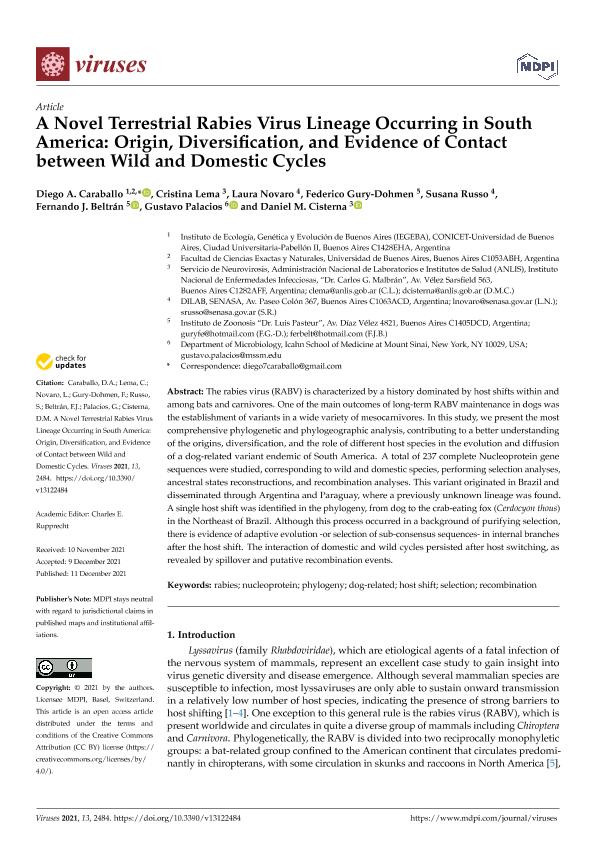Artículo
A novel terrestrial rabies virus lineage occurring in south america: Origin, diversification, and evidence of contact between wild and domestic cycles
Caraballo, Diego Alfredo ; Lema, Cristina; Novaro, Laura; Gury Dohmen, Federico; Russo, Susana; Beltrán, Fernando J.; Palacios, Gustavo; Cisterna, Daniel Marcelo
; Lema, Cristina; Novaro, Laura; Gury Dohmen, Federico; Russo, Susana; Beltrán, Fernando J.; Palacios, Gustavo; Cisterna, Daniel Marcelo
 ; Lema, Cristina; Novaro, Laura; Gury Dohmen, Federico; Russo, Susana; Beltrán, Fernando J.; Palacios, Gustavo; Cisterna, Daniel Marcelo
; Lema, Cristina; Novaro, Laura; Gury Dohmen, Federico; Russo, Susana; Beltrán, Fernando J.; Palacios, Gustavo; Cisterna, Daniel Marcelo
Fecha de publicación:
12/2021
Editorial:
MDPI
Revista:
Viruses
ISSN:
1999-4915
Idioma:
Inglés
Tipo de recurso:
Artículo publicado
Resumen
The rabies virus (RABV) is characterized by a history dominated by host shifts within and among bats and carnivores. One of the main outcomes of long-term RABV maintenance in dogs was the establishment of variants in a wide variety of mesocarnivores. In this study, we present the most comprehensive phylogenetic and phylogeographic analysis, contributing to a better understanding of the origins, diversification, and the role of different host species in the evolution and diffusion of a dog-related variant endemic of South America. A total of 237 complete Nucleoprotein gene sequences were studied, corresponding to wild and domestic species, performing selection analyses, ancestral states reconstructions, and recombination analyses. This variant originated in Brazil and disseminated through Argentina and Paraguay, where a previously unknown lineage was found. A single host shift was identified in the phylogeny, from dog to the crab-eating fox (Cerdocyon thous) in the Northeast of Brazil. Although this process occurred in a background of purifying selection, there is evidence of adaptive evolution-or selection of sub-consensus sequences-in internal branches after the host shift. The interaction of domestic and wild cycles persisted after host switching, as revealed by spillover and putative recombination events.
Palabras clave:
DOG-RELATED
,
HOST SHIFT
,
NUCLEOPROTEIN
,
PHYLOGENY
,
RABIES
,
RECOMBINATION
,
SELECTION
Archivos asociados
Licencia
Identificadores
Colecciones
Articulos(IEGEBA)
Articulos de INSTITUTO DE ECOLOGIA, GENETICA Y EVOLUCION DE BS. AS
Articulos de INSTITUTO DE ECOLOGIA, GENETICA Y EVOLUCION DE BS. AS
Citación
Caraballo, Diego Alfredo; Lema, Cristina; Novaro, Laura; Gury Dohmen, Federico; Russo, Susana; et al.; A novel terrestrial rabies virus lineage occurring in south america: Origin, diversification, and evidence of contact between wild and domestic cycles; MDPI; Viruses; 13; 12; 12-2021; 1-21
Compartir
Altmétricas



